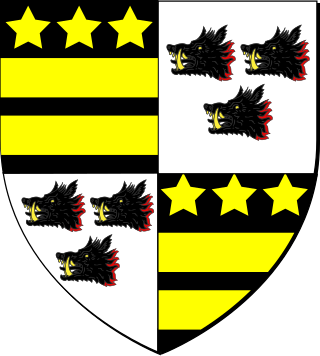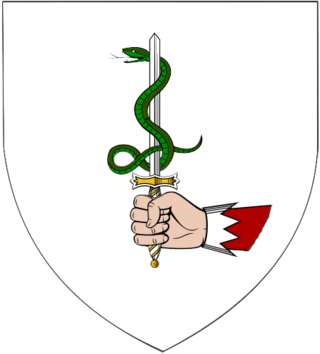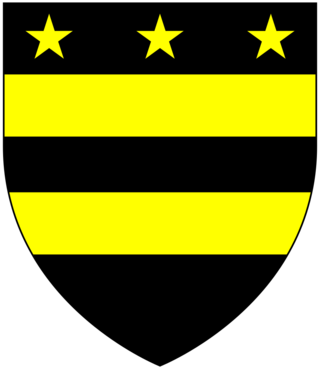Related Research Articles

Thomas Spring Rice, 1st Baron Monteagle of Brandon, was a British Whig politician, who served as Chancellor of the Exchequer from 1835 to 1839.

Baron Carbery, of Carbery in the County of Cork, is a title in the Peerage of Ireland. It was created in 1715 for George Evans, with remainder to the heirs male of his father and namesake George Evans, a supporter of William and Mary during the Glorious Revolution, who had earlier declined the offer of a peerage. After his elevation to the peerage, Lord Carbery represented Westbury in the House of Commons. He was succeeded by his eldest son, the second Baron. He also sat as Member of Parliament for Westbury. His grandson, the fourth Baron, briefly represented Rutland in Parliament. He was succeeded by his uncle, the fifth Baron. On his death, the line of the eldest son of the first Baron failed. He was succeeded by his first cousin once removed, the sixth Baron, who had previously succeeded his father as second Baronet, of Castle Freke. Lord Carbery sat in the House of Lords as an Irish representative peer from 1824 to 1845. His nephew, the eighth Baron, was an Irish Representative Peer from 1891 to 1894. As of 2014 the titles are held by the latter's great-great-grandson, the twelfth Baron, who succeeded his father in 2012.
George Evans, 1st Baron Carbery PC (Ire) was an Anglo-Irish politician and peer. A member of a County Limerick family of Whigs, he entered the Irish House of Commons and was created a peer in 1715 as a reward for his father's support of the Hanoverian succession, after his father declined the offer. At the same time, he was returned to the British House of Commons for Westbury. He contested control of the borough with the Tories led by the Earl of Abingdon until 1727, when he stood down.

The O'Donovan family is an ancient Irish noble family. Their patronymic surname derives from Irish Ó Donnabháin, meaning the grandsons or descendants of Donnubán, referring to the 10th century ruler of the Uí Fidgenti, Donnubán mac Cathail. During the 12th and 13th century, O'Donovan relations relocated from the Bruree/Croom area south to the Kingdom of Desmond and to Carbery, where they were a ruling family for centuries and played a role in the establishment of a feudal society under the MacCarthys. Other septs retreated into the southeast corner of the Ui Fidgheinte territory, reaching from Broadford/Feenagh to the Doneraile area. The northern septs of the O'Donovans did not use a White Rod as the family's position in their original territory was vastly eroded, while several septs of O'Donovans in the southwest territories were semi-autonomous flatha under the MacCarthy Reagh dynasty in Carbery, with the most notable being local petty kings. The family were counted among the leading Gaelic nobility of Ireland.

There have been two baronetcies created for persons with the surname Freke, one in the Baronetage of Great Britain and one in the Baronetage of Ireland.
Donal IV O'Donovan,, The O'Donovan, of Clancahill, was the son of Donal III O'Donovan, The O'Donovan of Clancahill, and Gyles (Sheela) O'Shaughnessy, daughter of Elis Lynch and Sir Roger Gilla Duff O'Shaughnessy, The O'Shaughnessy.

Carbery, or the Barony of Carbery, was once the largest barony in Ireland, and essentially a small, semi-independent kingdom on the southwestern coast of Munster, in what is now County Cork, from its founding in the 1230s by Donal Gott MacCarthy to its gradual decline in the late 16th and early 17th centuries. His descendants, the MacCarthy Reagh dynasty, were its ruling family. The kingdom officially ended in 1606 when Donal of the Pipes, 17th Prince of Carbery chose to surrender his territories to the Crown of England; but his descendants maintained their position in Carbery until the Cromwellian confiscations, following their participation in the Irish Rebellion of 1641 after which some emigrated to the Chesapeake Colonies.
Juliana Donovan, Countess of Anglesey, was the second or third wife, and later the widow, of the notorious Richard Annesley, 6th Earl of Anglesey, and mother of his son and heir Arthur Annesley, 1st Earl of Mountnorris. Much maligned by their numerous enemies, some of whom were relations of the earl, the countess became widely rumoured to be of very low birth and character. In doubt, and the subject of many proceedings during her life and following her death, was the date of her marriage to the 6th Earl and thus the legitimacy of his only son.

Eyre Massey, 1st Baron Clarina, was an Anglo-Irish British army officer of the 18th century, known primarily for his successful action at La Belle-Famille during the French and Indian War. In 1800, he was made Baron Clarina in the Peerage of Ireland.
The High Sheriff of Limerick was the British Crown's judicial representative in County Limerick, Ireland from the 13th century until 1922, when the office was abolished in the new Free State and replaced by the office of Limerick County Sheriff. The sheriff had judicial, electoral, ceremonial and administrative functions and executed High Court Writs. In 1908, an Order in Council made the Lord-Lieutenant the Sovereign's prime representative in a county and reduced the High Sheriff's precedence. However, the sheriff retained his responsibilities for the preservation of law and order in the county. The usual procedure for appointing the sheriff from 1660 onwards was that three persons were nominated at the beginning of each year from the county and the Lord Lieutenant then appointed his choice as High Sheriff for the remainder of the year. Often the other nominees were appointed as under-sheriffs. Sometimes a sheriff did not fulfil his entire term through death or other event and another sheriff was then appointed for the remainder of the year. The dates given hereunder are the dates of appointment. All addresses are in County Limerick unless stated otherwise.

Sir Ralph Freke, 1st Baronet of West Bilney, Norfolk, and Rathbarry, County Cork, was a baronet in the Baronetage of Great Britain and a Member of Parliament in the Irish House of Commons.

Sir John Redmond Freke, 3rd Baronet was a baronet in the Baronetage of Great Britain and a member of parliament in the Irish House of Commons.

Francis William Ogilvie-Grant, 10th Earl of Seafield, styled Viscount Reidhaven from 1884 to 1888, was a Scottish peer who emigrated to New Zealand.
George Evans, 2nd Baron Carbery, known until 1749 as Hon. George Evans, was a British politician. Like his father, he represented Westbury as a Whig. Evans entered the British House of Commons in 1734 as a supporter of the Walpole administration. He was in financial difficulties by 1743, and did not stand for election again in 1747. Succeeding his father as an Irish peer in 1749, he sat in the Irish House of Lords until his death a decade later.
George Evans, 3rd Baron Carbery, known as Hon. George Evans from 1749 to 1759, was an Irish peer. He probably built the house later enlarged as the present Laxton Hall.
John Rochfort was a member of the pre-1801 Parliament of Ireland, in the Irish House of Commons.

Castlefreke, also known as Rathbarry, is a townland and village in County Cork, Ireland. The townland is located in the civil parish of Rathbarry on the R598 regional road, to the east of Rosscarbery.
Herbert Webb Gillman was a Ceylonese Judge, the Postmaster General of Ceylon between 1867 and 1871 and an Irish historian.
Donal MacCarthy Reagh of Kilbrittain was an Irish magnate who owned the extensive lands of Carbery in south-western County Cork.
George Evans PC(I) was an Anglo-Irish politician.
References
- 1 2 "Evans (Ash Hill Towers) | Landed Estates | University of Galway". landedestates.ie.
- ↑ Burke, John (1833). A Genealogical and Heraldic History of the Commoners of Great Britain and Ireland, Enjoying Territorial Possessions Or High Official Rank: But Uninvested with Heritable Honours. Henry Colburn.
- ↑ Lord Strathspey (1983). A History of Clan Grant. Phillimore. ISBN 978-0-85033-442-5.
- ↑ Journal of the Cork Historical and Archaeological Society. Cork Historical and Archaeological Society. 1892. p. 74.